Selling things is no longer the only goal of modern marketing; instead, it involves forging deep connections, resolving actual issues, and crafting gripping narratives that appeal to consumers. Think about the last time you bought something online. Was it a catchy Instagram ad? A YouTube influencer raving about it? Or perhaps a personalized email that felt like it was written just for you? That’s modern marketing in action—smart, subtle, and made to match your needs.
Table of Contents
Today’s marketers blend creativity with data, leveraging technology to understand what makes you tick. Marketing is about content that engages you, social media buzz, ethics, and values you hold dear. By winning trust and building genuine connections, brands create value that matters. Marketing today is about meeting people wherever they are—online, offline, or in between—and making them feel truly seen and appreciated.
So, whether it’s AI recommending your next favorite product or brands going green to align with your eco-conscious mindset, are all about keeping things fresh, exciting, and, most importantly, human. Welcome to a world where marketing doesn’t just sell—it connects.
What Is Modern Marketing?
Modern marketing is a strategy that focuses on understanding customer needs and creating personalized experiences using digital channels like social media, email, content marketing, and data analytics. Unlike traditional marketing, which mainly focuses on selling, modern marketing builds long-term relationships with customers by offering value, engaging content, and targeted communication. It’s a more interactive, data-driven, and customer-centric approach that helps brands connect with the right audience more effectively.
Some of the most popular modern marketing strategies today include:
- Social Media Marketing
- Content Marketing
- Email Marketing
- Influencer Marketing
- SEO (Search Engine Optimization)
- Paid Digital Ads (like Google or Facebook Ads)
- Data-Driven Marketing
Meaning of Modern Marketing Concepts
Modern marketing concepts involve value creation for the customer as well as building long-term relationships. Unlike the old marketing that had a lot of emphasis on a product-based approach, modern marketing is more consumer-centric in the sense that it focuses more on the wants and needs of the consumer. A basic element of modern marketing is the 7Ps of marketing (product, price, place, promotion, people, process, and physical evidence), which are designed to meet the requirements and desires of the consumer while ensuring efficient distribution and communication.
Furthermore, by combining data analytics, social media, content marketing, and personalization, digital transformation has completely changed the marketing management industry. These days, marketers use tools like customer relationship management (CRM) systems to comprehend consumer behavior and provide campaigns that are specifically targeted.
The concept of sustainability and ethics has gained prominence because consumers increasingly demand transparency and social responsibility from brands. Modern marketing concepts also focus on experiential marketing, where companies engage consumers through memorable, interactive experiences that resonate with their values and emotions. This approach builds trust, loyalty, and brand advocacy, ensuring long-term success.
Also read: Evolution of Marketing
Importance of Modern Marketing Concepts
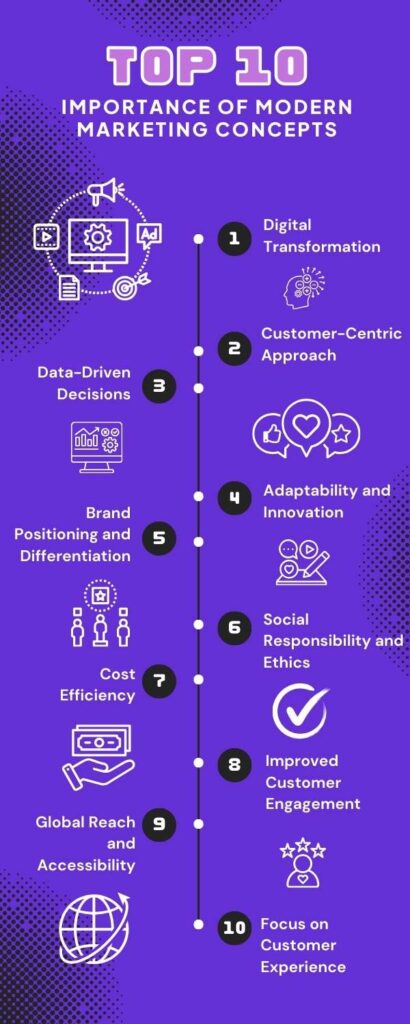
1. Customer-Centric Approach
In modern marketing, the focus shifts to understanding customers’ unique needs and catering to them. A customer-centric approach helps businesses place value delivery over the simple pushing of products to the customer. Because customer behavior, preferences, and feedback are analyzed, this can build stronger relationships, create brand loyalty, and increase satisfaction. This approach creates solutions that resonate with the audience and make deeper emotional connections, leading to long-term success. The secret is to pay attention to what customers have to say, adjust to their evolving needs, and give them the impression that the brand cares about them.
2. Data-Driven Decisions
Data is becoming the foundation of modern marketing. Marketers are able to make well-informed decisions, optimize campaigns, and gain a detailed understanding of customer behavior when they have access to plenty of data from several touchpoints. By using real-time analytics to inform their decisions, brands are able to increase efficiency and return on investment. Data-driven marketing improves targeting, hones messaging, and boosts conversions using customer analytics, A/B testing, or predictive modeling. In a rapidly changing environment, companies make sure they remain effective and relevant by continuously evaluating and modifying their tactics.
3. Digital Transformation
There is no denying the digital revolution in marketing. Since the rapid expansion of the internet, social media, and other online tools, businesses have bid farewell to traditional marketing strategies and shifted their focus toward digital marketing. It has made brands able to reach audiences worldwide, engage with customers in real time, and optimize campaigns for maximum impact. With this comes advanced targeting, more measurable results, and a wider number of channels- including social, email, search, and even paid ads through digital marketing. Digital companies continue to stay up to date through innovative solutions tailored to new behaviors and technologies exhibited by consumers, allowing them to be competitive in the market.
Enroll Now: Performance Marketing Training
4. Brand Positioning and Differentiation
Having a solid brand positioning is crucial in the competitive market of today. Businesses must clearly articulate their distinct value proposition if they want to differentiate themselves from the competition. Customers will perceive your brand as unique, pertinent, and useful if it is positioned correctly. Product attributes, brand personality, customer support, or even a distinctive brand narrative can all help create differentiation. Brands may attract specialized audiences and foster enduring loyalty by highlighting their unique selling points. Good positioning conveys the brand’s identity, values, and reasons for consumers to pick it over competing products.
5. Social Responsibility and Ethics
Modern consumers increasingly expect brands to act responsibly and ethically. Whether it’s sustainability, fair labor practices, or contributing to social causes, businesses are under pressure to align their actions with their values. Social responsibility builds trust and credibility with customers, which is crucial in today’s market. Ethical branding helps establish a positive reputation, foster customer loyalty, and attract a like-minded audience. As consumers become more conscious of where their money goes, brands that take a stand on social issues and prioritize corporate social responsibility can differentiate themselves and create meaningful connections with their customers.
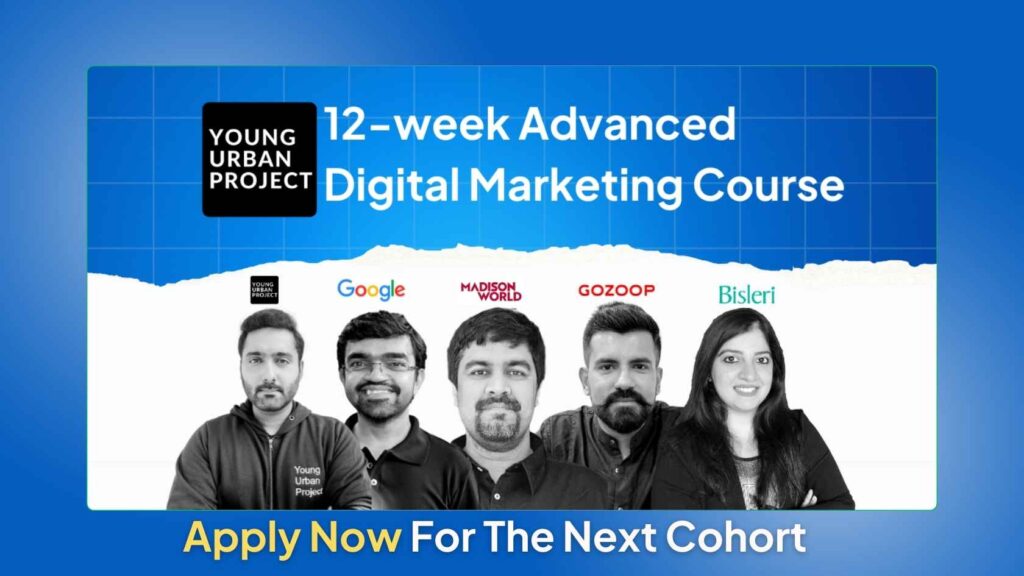
Apply now for our 12-Week Advanced Digital Marketing
6. Improved Customer Engagement
Modern marketing concepts are built on the foundation of customer engagement. In a time when consumers have more options than ever before, it’s critical to keep them interested and build a relationship. Personalized communication, useful information, and prompt responses are all part of engagement, which is more than just selling a product. A unified communication platform plays a key role in enabling seamless interaction across multiple channels—social media, email marketing, and live chat—allowing brands to stay in touch with their customers, respond to inquiries, and provide insightful information. Customers who are actively involved with a brand are more inclined to spread the word about it, become devoted supporters, and promote it. Prioritizing engagement helps companies build a more significant and enduring clientele.
7. Focus on Customer Experience
The customer experience (CX) has become one of the most important aspects of modern marketing. Today’s consumers expect seamless, consistent, and personalized interactions across all touchpoints, whether online or offline. A great CX builds loyalty and increases the chances of repeat business, while a poor one can drive customers away. Brands focus on delivering smooth, intuitive experiences through website optimization, user-friendly apps, and exceptional customer service. Listening to customer feedback and continually improving interactions ensures that companies meet and exceed expectations. Investing in CX is essential for long-term business success in a competitive landscape.
8. Global Reach and Accessibility
Reaching a worldwide audience is one of the major benefits of modern marketing. It is now simpler than ever for companies to reach customers around the world and grow beyond local markets courtesy of the development of digital platforms and internet technologies. This worldwide presence gives brands access to a variety of markets and creates fresh growth prospects. Mobile-friendly websites, social media channels, and e-commerce platforms also increase accessibility by enabling consumers to interact with brands at any time and from any location. This greater accessibility gives businesses the chance to grow rapidly and satisfy the needs of a worldwide, connected customer base.
9. Cost Efficiency
The new methods of marketing, especially digital ones, have changed the way businesses distribute their budgets. Social media ads, SEO, and email marketing allow brands to reach a highly targeted audience at a fraction of the cost of traditional advertising methods. Also, performance can be tracked in real time, and adjustments can be made to ensure maximum efficiency. This cost-effectiveness enables even the smallest business ventures to compete with larger companies. By wisely utilizing resources and using strategies that bring measurable returns on investment, firms can deliver major results without blowing their budget.
10. Adaptability and Innovation
Adaptability and innovation are critical for maintaining competitiveness in a world that is constantly changing. The field of marketing is always changing as new tools, technology, and trends appear on a regular basis. In order to satisfy consumer expectations, successful brands welcome change and never stop innovating. Flexibility is essential when implementing new digital platforms, trying out innovative advertising strategies, or reacting to changes in customer behavior. Companies that remain ahead of the curve by experimenting with novel concepts and adopting cutting-edge technologies can not only stay relevant but also influence marketing in the future. Businesses can stay vibrant and prosper in a constantly shifting environment by being innovative and adaptable.
Also Read: AI in Marketing Strategy
5 Modern Marketing Concepts
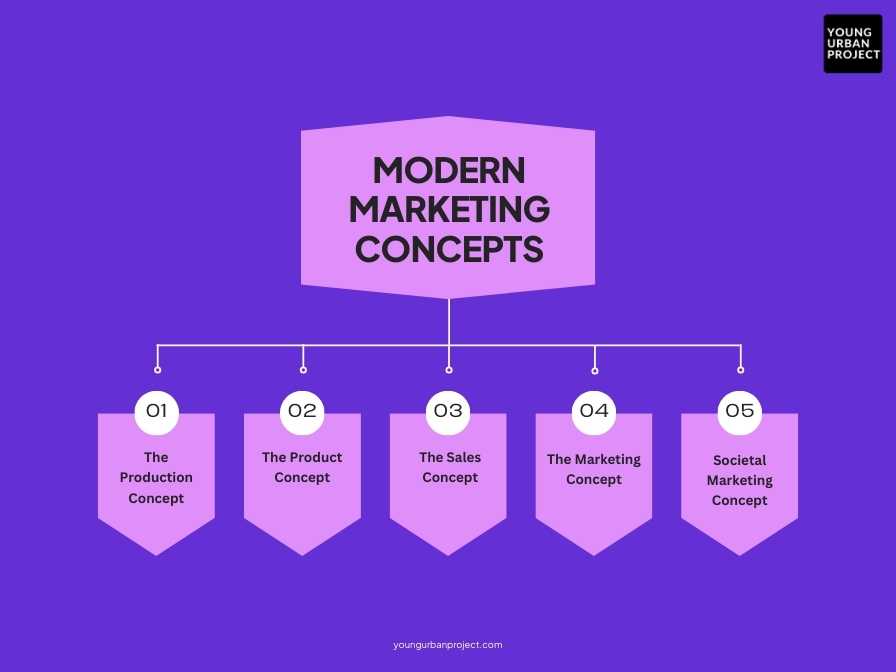
1. The Production Concept
The production concept revolves around the belief that customers have an affinity towards mass-produced, relatively cheap products. Thus, a company should aim for efficiency in producing and distributing goods to have them reach a wide number of consumers. In simple words, the belief here is that the customer will surely arrive if a product is not very expensive and widely available. While this approach works well in environments where demand outpaces supply, it may not be as effective in today’s highly competitive market, where consumer preferences and personalization are crucial. However, for industries that produce large quantities of everyday goods, this concept remains a fundamental strategy to stay ahead of the competition.
2. The Product Concept
The underlying assumption of the product concept is that consumers will choose goods with the best features, performance, and quality. Businesses that accept this idea frequently concentrate on enhancing the functionality and design of their products because they think that a better product would inevitably result in market success. While product innovation and quality are essential, this concept can overlook the customer experience and the need for effective marketing. In today’s market, where customer tastes can shift quickly, concentrating just on product attributes while ignoring customer trends and wants may lead to lost chances.
3. The Sales Concept
The sales concept revolves around the notion that aggressive selling and promotional strategies are necessary to convince consumers to purchase goods. This type of business usually concentrates on increasing sales through direct selling, discounts, and promotion. It is based on the assumption that consumers will not purchase enough of the product unless they are convinced to do so. Although this approach may generate short-term sales, it is not always sustainable. This leads to consumer fatigue, brand fatigue, and no loyalty. Modern marketing, in contrast, places a strong emphasis on developing relationships and providing customers with value that appeals to them and makes them feel more naturally inclined to purchase.
4. The Marketing Concept
Customer satisfaction is what the marketing concept all is about. This idea further adds that companies need to look out for ways and means by which their customers’ needs and wants can be satisfied in a way better than competitors do. Long-term customer relationships built with quality experiences for the customers mean being loyal for continued return visits. A comprehensive marketing concept focuses on all areas-including product development, pricing, distribution, and promotion to provide value to the customer. It challenges businesses to listen to their customers and be adaptable in responding to changes in market conditions and preferences so as to stay competitive in the long term.
5. Societal Marketing Concept
The societal marketing concept takes a step beyond customer satisfaction and focuses on the broader societal implications of a business’s actions. It integrates social responsibility with traditional marketing practices, encouraging companies to not only meet customer needs but also to consider the impact on society and the environment. This concept recognizes that consumers today are increasingly conscious of a brand’s ethical practices, sustainability, and contributions to social causes. By embracing the societal marketing concept, businesses can build stronger brand loyalty, attract like-minded customers, and foster a positive brand image that aligns with the values of both the market and society at large.
Also read: Understanding the Principles of Marketing
Essential Characteristics of the Marketing Concept
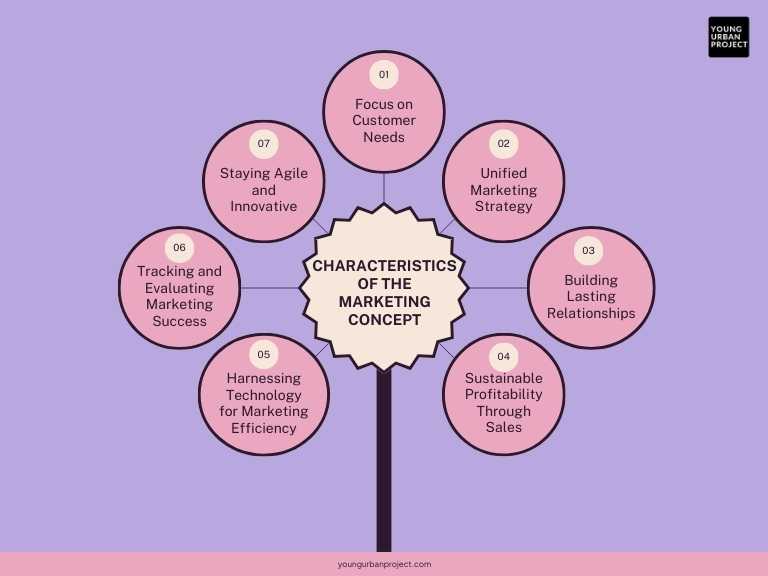
1. Focus on Customer Needs
Think about the brands you love—chances are, they just get you. That’s the power of focusing on customer needs. It’s not about selling what’s easiest to make; it’s about creating solutions that genuinely improve lives. Whether it’s through sleek designs, personalized offers, or solving everyday problems, businesses that prioritize customer needs become memorable. This isn’t guesswork—it’s about digging deep, understanding what makes your audience tick, and delivering products or services that make them feel heard, valued, and connected. When customers see that a brand truly cares, loyalty naturally follows.
2. Unified Marketing Strategy
Have you ever attempted to solve a problem using pieces from other sets? Disjointed marketing seems like that. Every division—marketing, sales, and customer service—is pursuing the same objective when there is a single plan in place. Similar to an orchestra, the outcome is stunning when everyone is playing in unison. This smooth partnership guarantees that consumers have a uniform experience across all touchpoints, including advertisements, websites, and in-store visits. The goal is to establish harmony so that your audience perceives your brand as a whole rather than as a patchwork of disparate initiatives.
3. Building Lasting Relationships
Although it may seem fantastic to get quick wins, the magic happens in relationships that last. Customers of today desire a connection more than a product. Developing connections entails going above and beyond business dealings, supporting your clients, and demonstrating your long-term commitment. These little actions add up, whether it’s through loyalty programs, tailored emails, or meaningful social media participation. Customers who have faith in your brand will not only return but also refer their friends. Building a brand-loving and brand-advocating group is more important than simply making sales.
4. Sustainable Profitability Through Sales
Forget the hard sell—today’s winning strategy is about creating value. Sustainable sales happen when businesses focus on products that people truly want and are willing to buy again and again. It’s not about flashy campaigns or gimmicks; it’s about building trust and delivering quality. By focusing on meeting real needs, companies create loyal customers who stick around for the long term. The result? A steady, profitable sales pipeline that grows organically. The goal isn’t just to make a sale—it’s to make your customers feel so satisfied they come back on their own.
5. Harnessing Technology for Marketing Efficiency
Marketing in the digital age is like having a superpower. Automation tools and cutting-edge tech take the guesswork out of campaigns, freeing up time to focus on creativity. From automated email campaigns to AI-powered customer insights, technology helps businesses target the right people at the right time with precision. It’s not just about saving time—it’s about working smarter. With tech on your side, you can deliver personalized experiences, track results, and adapt strategies in real-time, giving you the competitive edge to stand out in a crowded market.
6. Tracking and Evaluating Marketing Success
How do you determine what is effective if you aren’t measuring? The key to successful marketing is performance tracking. Analyzing indicators, such as website traffic, sales conversions, or social media engagement, enables you to determine where to focus and where to change course. But knowing the story behind the numbers is just as important as knowing the numbers themselves. A campaign that resonates, inspires action, and yields results is more than just one that looks beautiful. Businesses can make better judgments and make sure every marketing dollar counts by regularly assessing their efforts.
7. Staying Agile and Innovative
You can’t stand stationary in a world where trends shift all the time. Agility and innovation are what separate leaders from the rest. It’s about spotting opportunities, embracing new ideas, and experimenting fearlessly. Whether it’s adopting a new platform, testing fresh content formats, or leveraging the latest tech, being adaptable keeps businesses ahead of the curve. Customers notice brands that are always evolving to meet their needs. Staying agile isn’t just about keeping up—it’s about leading the way and setting new standards for the industry.
Also read: 10 Digital Marketing Objectives to Skyrocket Your Business Growth
Steps for Implementing the Marketing Concept
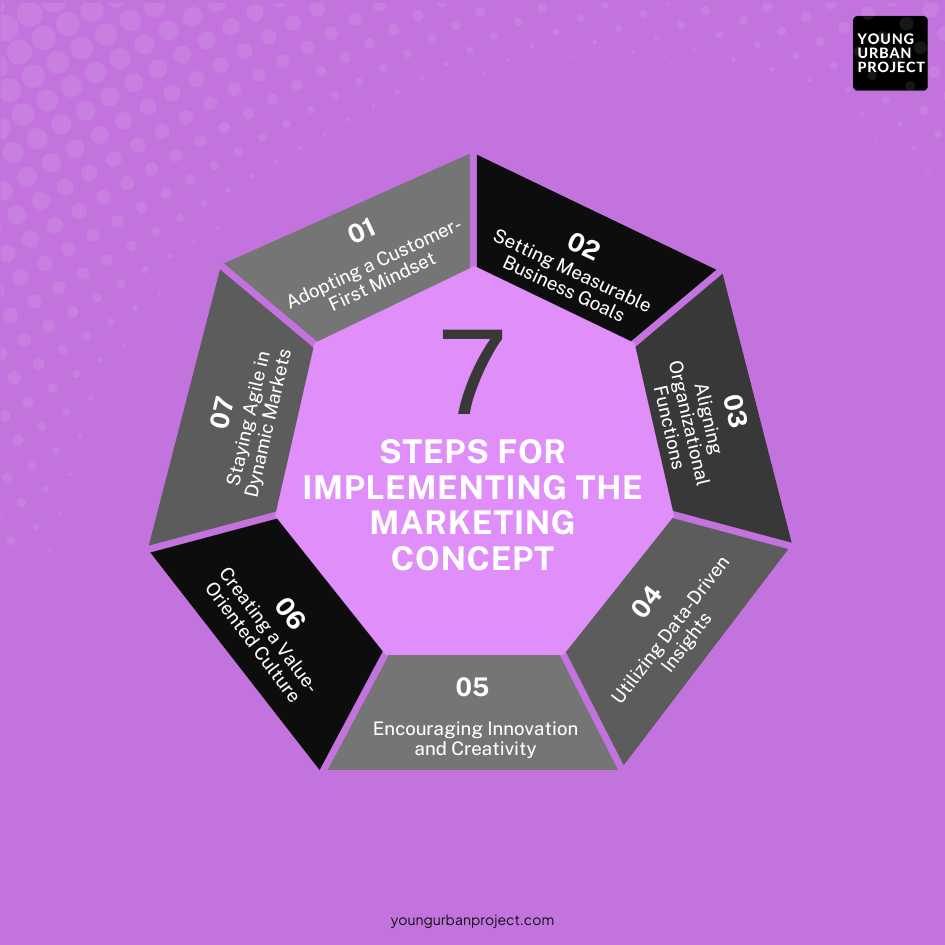
1. Adopting a Customer-First Mindset
A customer-first mindset isn’t just a strategy; it’s a philosophy. It means putting yourself in your customers’ shoes and designing products, services, and experiences that truly address their needs. This approach goes beyond selling—it’s about building trust and loyalty by consistently delivering value. Companies that adopt this mindset actively listen to feedback, analyze behavior, and stay connected with their audience. When customers feel valued and understood, they don’t just stick around—they become your biggest advocates, spreading the word and strengthening your brand’s reputation.
2. Setting Measurable Business Goals
Having specific goals is the first step to success. Establishing quantifiable goals guarantees that your marketing initiatives are targeted and successful. Setting clear goals aids teams in coordinating their tactics, whether the goal is raising sales, improving website traffic, or raising brand awareness. These objectives must be challenging yet doable, supported by deadlines for monitoring advancement. Regular reviews are also made possible by measurable goals, which guarantee that changes can be made to maximize outcomes. Teams are inspired to strive toward a common goal when they have clear objectives because they foster accountability and a feeling of purpose.
3. Aligning Organizational Functions
Marketing doesn’t operate in a silo—it thrives when every department works together. Aligning functions like sales, customer support, and product development ensures that everyone is on the same page. This integration allows businesses to deliver consistent messaging and seamless customer experiences across all touchpoints. Collaboration also fosters creativity, as diverse perspectives come together to solve challenges. When all departments are united in purpose, the result is a cohesive brand that resonates with customers and achieves long-term success.
4. Utilizing Data-Driven Insights
In today’s digital world, data is gold. Businesses can use analytics to uncover customer preferences, track buying behavior, and predict trends. This information helps refine strategies, ensuring campaigns are relevant and targeted. Instead of guessing, marketers can make informed decisions that save time and resources. Data-driven insights also allow businesses to personalize their approach, creating deeper connections with customers. With the right data tools, companies can stay one step ahead, adapting quickly to changing market dynamics and driving better results.
5. Encouraging Innovation and Creativity
It takes bold ideas and fresh perspectives to stand out in a crowded market. Encouraging innovation and creativity involves allowing teams the freedom to think creatively and take measured chances. Innovation keeps brands interesting and current, whether it’s by redesigning a product or starting an unusual advertising campaign. Being creative is about finding original solutions to problems, not only about creating eye-catching designs. Businesses may adjust to change, take advantage of new opportunities, and surprise their customers by creating an atmosphere where ideas are allowed to flow freely.
6. Creating a Value-Oriented Culture
A value-oriented culture puts customer satisfaction ahead of fast profits. The idea is to create trust and long-term relationships by providing quality and reliability time after time. The companies that believe in this culture are transparent, ethical, and committed to the task of going beyond expectations. Employees in these organizations feel empowered to make decisions that benefit the customer. Eventually, this becomes a hallmark of a brand that differentiates it from others and provides sustained growth. A business that serves the customers’ best interests adds value and earns not only sales but lifelong loyalty.
7. Staying Agile in Dynamic Markets
Markets are always changing, and companies that can quickly adapt are the ones that thrive. Being agile entails being prepared to change tactics, adopt new styles, and react quickly to client input. The goal is to stay ahead of the competition and keep an ear to the ground. Agile companies try new things, learn from mistakes, and improve fast. In addition to assisting them in navigating ambiguities, this adaptability establishes them as leaders in their field. Agility is essential to surviving and remaining relevant in a world where change is the only thing that is constant.
Also read: Scope of Marketing
Advantages of Marketing Concepts
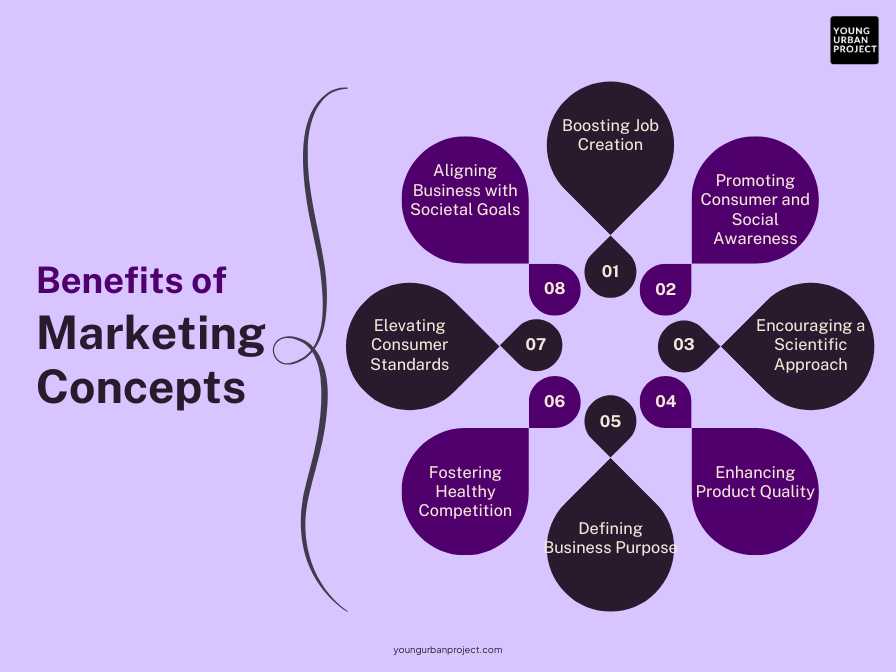
1. Boosting Job Creation
Marketing is a job creation powerhouse. There are advertising agencies, social media management, content creation, and market research, just to name a few. In the marketing sector, there is a wide array of career options, and as the business grows and expands, so does the need for skilled marketers. It not only creates jobs in traditional marketing avenues but also opens up new careers in digital marketing, influencer marketing, and data analytics. Since companies are growing and innovating to expand worldwide, they require marketing experts to implement their messaging and touch new customers. The rippling effect helps in reducing unemployment rates, thus stimulating the job market.
2. Promoting Consumer and Social Awareness
In today’s world, marketing isn’t just about selling products—it’s also about educating the public. Through impactful campaigns, brands can raise awareness of social issues, environmental concerns, and consumer rights. By promoting responsible consumption and ethical practices, marketing helps build a more conscious society. When businesses prioritize sustainability or highlight important causes, they use their platforms to engage with consumers and spark meaningful conversations. This not only benefits brands but also contributes to the greater good, encouraging consumers to make informed decisions that impact the world in a positive way.
3. Encouraging a Scientific Approach
Modern marketing thrives on data and analytics. By employing a scientific approach, marketers can measure consumer behavior, track campaign performance, and fine-tune strategies based on evidence rather than assumptions. Data-driven decisions allow for more precise targeting and better outcomes. Marketing research methods like A/B testing, consumer surveys, and market segmentation provide valuable insights that help businesses understand what works and what doesn’t. This approach ensures that marketing efforts are both efficient and effective, minimizing guesswork and maximizing return on investment. It’s not just creativity—it’s creativity backed by science.
4. Enhancing Product Quality
By promoting feedback loops between companies and customers, marketing significantly contributes to improving the quality of products. Brands may learn what needs to be improved, what features consumers want, and what issues still need to be resolved by actively listening to their customers. Businesses are pushed to innovate, improve their products, and adapt to changing consumer expectations by this consumer-driven approach. Companies are forced to enhance their standards in competitive markets due to the constant feedback and desire for greater quality, which results in better, more efficient products. Quality may become a strong selling feature and foster brand loyalty in addition to helping to please customers.
5. Defining Business Purpose
A clear marketing strategy goes hand in hand with a well-defined business purpose. Marketing helps businesses convey their mission and values to the world, allowing customers to know the “why” behind products or services sold. A strong business purpose helps the company stand out in a market that is crammed with options and resonates with its target audience on a deeper level. Whether it is about sustainability, community empowerment, or innovation, defining a purpose for a company will shape its identity and lay the foundation for growth. It will give direction and accountability that can be rallied around by employees and consumers alike.
6. Fostering Healthy Competition
Marketing is a driving force behind healthy competition in any industry. By promoting unique selling propositions and emphasizing innovation, marketing pushes companies to continuously improve and offer better products, services, and experiences. Consumers benefit from this competitive environment, as businesses vie for attention by offering higher quality, better pricing, and enhanced customer experiences. Healthy competition also encourages companies to adopt more sustainable and ethical practices, which can ultimately lead to greater consumer trust and satisfaction. It’s a win-win for both businesses and the customers they serve.
7. Elevating Consumer Standards
Marketing seeks to both challenge and elevate consumer expectations in addition to meeting them. As companies launch new goods, services, and experiences, they raise the bar for creativity and excellence. Better value, convenience, or technology-focused marketing initiatives encourage consumers to demand more from the companies they support. These strict requirements eventually encourage industries to enhance their products, which is advantageous to all parties. Customers are now increasingly demanding, empowered, and knowledgeable, which propels ongoing innovation and development across all sectors of the economy.
8. Aligning Business with Societal Goals
Today’s consumers care deeply about the ethical values of the companies they support. Businesses that ensure their marketing aligns with society’s goals in terms of sustainability, inclusiveness, or social justice build a better connection with the audience. Marketing enables companies to convey their adherence to these values and blend them into their business practices. The brands build trust and loyalty with their audience and contribute to the larger good by taking the role of responsible corporate citizens. This alliance therefore works in a harmonious way such that both parties benefit, which ensures long-term success that transcends profit.
Traditional vs. Modern Marketing: What’s the Difference?
Marketing practices have changed considerably, with old practice methods gradually being surpassed by new ones. Where traditional marketing depends on a passive one-way communication through print advertisements, television, and billboards, modern marketing relies on digital platforms and interactive customer engagement with the help of data analytics. The general shift reflects a more connected, technology-driven world, requiring business changes in keeping with what has happened to consumer behavior. Understanding the difference between traditional and modern marketing is crucial for businesses looking to stay competitive and effectively reach their target audience.
Below is the table highlighting the differences between Traditional and Modern Marketing:
| Aspect | Traditional Marketing | Modern Marketing |
| Channels Used | Primarily offline channels: TV, radio, print media, billboards | Primarily digital channels: social media, email, websites, search engines |
| Audience Reach | Targets a broad, mass audience without much segmentation | Highly segmented, targeting specific audiences using data-driven insights |
| Customer Engagement | One-way communication, limited interaction | Two-way communication, engaging directly with customers through social media and personalized content |
| Cost | Typically higher due to expenses like media buys and printing | Can be more cost-effective with the ability to scale through digital platforms |
| Measurement of Success | Difficult to track ROI accurately, relies on general metrics like reach | Real-time, measurable results through metrics like clicks, conversions, and engagement rates |
| Personalization | Limited to demographic targeting (age, gender, location) | Highly personalized content based on customer behaviors, preferences, and data |
| Flexibility | Less adaptable once a campaign is launched; limited scope for real-time changes | Agile and adaptable, enabling rapid changes and optimizations during a campaign |
| Interactivity | Limited customer interaction; usually passive consumption of ads | High interactivity, allowing customers to comment, share, and provide feedback instantly |
| Content Creation | Mostly static content like brochures, flyers, and ads | Dynamic content such as videos, blogs, infographics, and interactive posts |
| Customer Feedback | Hard to gather real-time feedback, typically through surveys | Instant feedback through social media comments, reviews, and direct messages |
| Campaign Duration | Longer campaign cycles, often with planned media schedules | Shorter, more frequent campaigns, often leveraging real-time trends and opportunities |
| Targeting Precision | Broad targeting with limited refinement based on mass demographics | Highly refined targeting using tools like Google Analytics, Facebook Ads, and more |
| Brand Awareness | Built through repetition and broad exposure in public spaces | Gained through content marketing, influencer partnerships, and viral campaigns |
| Strategy Focus | Focused more on awareness and broad reach | Focused on conversion, engagement, and building long-term customer relationships |
Final thoughts
In today’s fast-paced business world, modern marketing concepts are more crucial than ever. They represent a shift from traditional methods to more dynamic, customer-centric approaches. Instead of simply pushing products, modern marketing focuses on building meaningful connections, understanding customer needs, and delivering value through innovative strategies. By integrating technology, data analytics, and social media, businesses are able to create personalized experiences that resonate with their target audience. From the production concept to societal marketing, each concept has its role in shaping a business’s success. The importance of these concepts lies not just in selling a product, but in fostering long-term relationships with consumers. By understanding and implementing these strategies, companies can stay ahead of the curve, streamline operations, and position themselves as industry leaders. Modern marketing is no longer just about selling; it’s about creating a lasting impression, building trust, and delivering consistent value.
FAQs: Modern Marketing Concepts
1. What are the key marketing concepts commonly used in the industry?
Common marketing concepts include production, product, sales, marketing, and societal marketing concepts. These concepts guide businesses in product creation, customer needs, communication, brand positioning, and social responsibility, aiming for customer satisfaction, brand loyalty, and long-term business success.
2. How can I simplify marketing concepts when preparing for an interview?
To simplify marketing concepts, break them down into clear, digestible elements. Focus on explaining key terms with real-life examples. Prioritize understanding of the core concepts like the 4Ps, customer segmentation, and branding, and relate them to practical business scenarios to make them more relatable.
3. What are the fundamental concepts of digital marketing?
Digital marketing fundamentals comprise SEO (Search Engine Optimization), SEM (Search Engine Marketing), content marketing, social media marketing, email marketing, and online advertising. It helps the brands reach out to their audience by using a host of digital mediums, bringing them traffic, engagement, and conversion.
4. How do traditional and modern marketing differ?
Traditional marketing targets wide audiences through offline media including print, radio, and television advertisements. In contrast, contemporary marketing places a strong emphasis on two-way communication through digital channels, emphasizing data insights, personalization, and real-time engagement to build stronger relationships with clients.
5. What is the importance of customer-centric marketing?
Customer demands, preferences, and experiences are the main focus of customer-centric marketing. By strengthening relationships, improving customer happiness, and boosting loyalty, it helps businesses achieve long-term success and raise lifetime customer value.
6. How can I apply data-driven strategies in marketing?
To apply data-driven strategies in marketing, start by gathering data on your customers’ behaviors, preferences, and demographics through tools like Google Analytics or CRM systems. Analyze this data to identify patterns and trends, then use those insights to tailor your campaigns. By continuously tracking performance and adjusting your approach, you can improve your marketing efforts and deliver more targeted, effective results.

